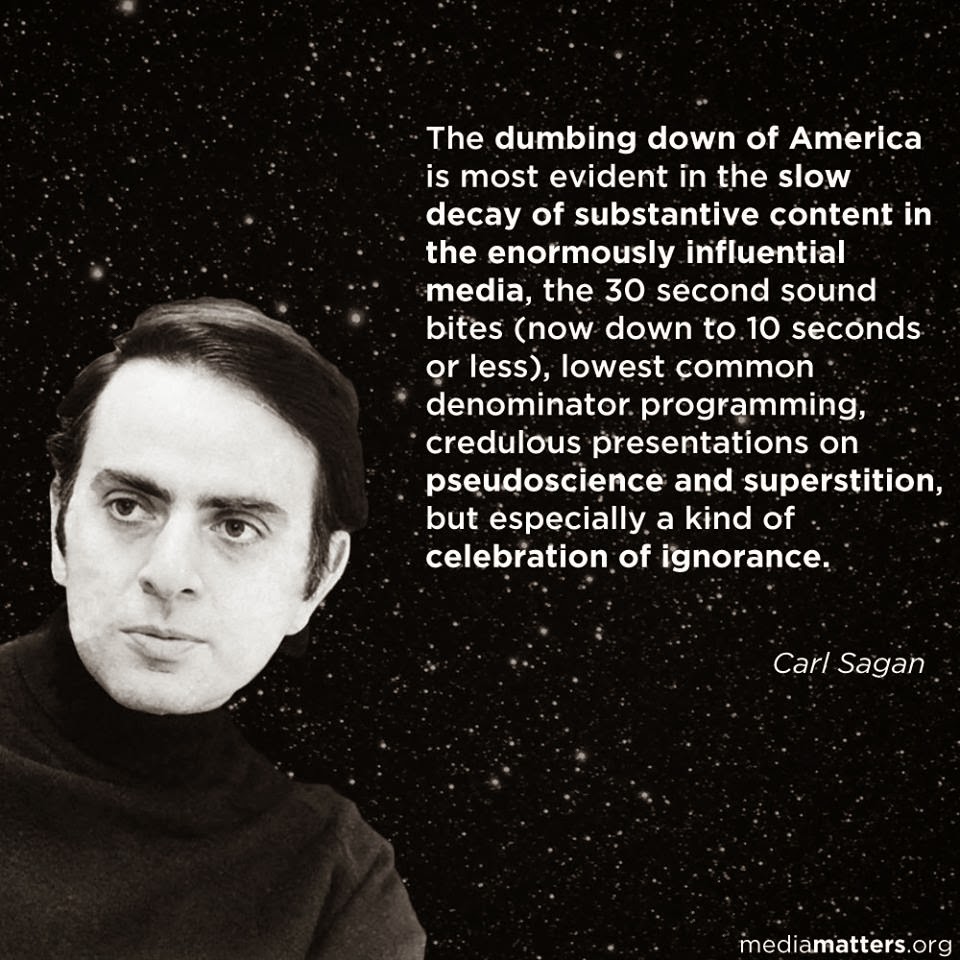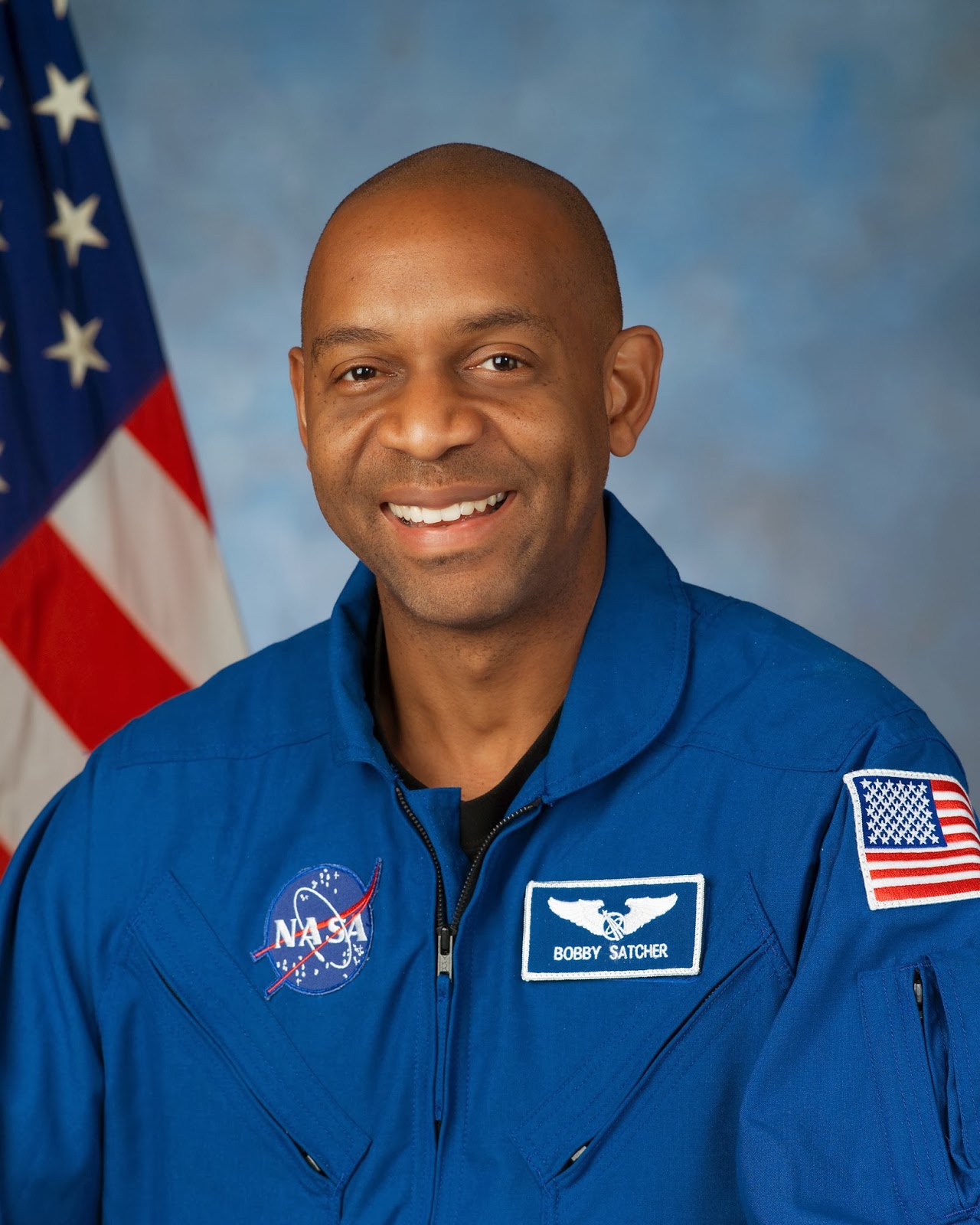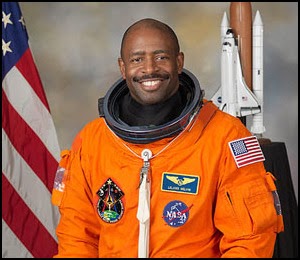Link: LiveFromSpace.com
Reginald L. Goodwin's Posts (3117)
Source: Quantum Made Simple
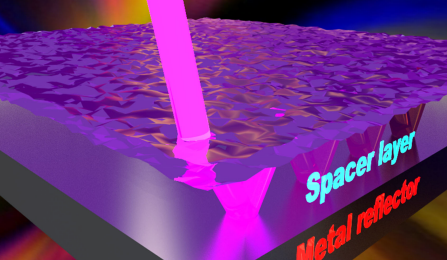 |
| A rendering shows a beam of light interacting with an optical nanocavity. The nanocavity boosts light absorption in ultrathin semiconductors. Credit: Advanced Materials |
By Cory Nealon
Release Date: March 5, 2014
BUFFALO, N.Y. – Associated with unhappy visits to the dentist, “cavity” means something else in the branch of physics known as optics.
Put simply, an optical cavity is an arrangement of mirrors that allows beams of light to circulate in closed paths. These cavities help us build things like lasers and optical fibers used for communications.
Now, an international research team pushed the concept further by developing an optical “nanocavity” that boosts the amount of light that ultrathin semiconductors absorb. The advancement could lead to, among other things, more powerful photovoltaic cells and faster video cameras; it also could be useful for splitting water using energy from light, which could aid in the development of hydrogen fuel.
The team, comprised of faculty and students from the University at Buffalo and two Chinese universities, presented its findings Feb. 24 in the journal Advanced Materials. The paper, called “Nanocavity enhancement for ultra-thin film optical absorber,” is available here: http://bit.ly/1bGGIbO.
University of Buffalo: An (optical) cavity that you want
 |
| A faux historical account of Earth "pre-warp" |
Warp drive, as enthusiastically a Trekkie I am, was a plot device created by Gene Roddenberry to get his astronauts from "here-to-there" in a reasonable amount of time to tell a story in an hour or less. NASA on the other hand, needs something other than chemical rockets that once the fuels expended to get the rocket into orbit - Newton's Laws dominate. Which is why currently a manned trip to Mars would take ~ 7 months to 300 days, and have astronauts with muscles of mush and bone mass of jello. VASIMR may get us there one day, thanks to the diligent research of people like Franklin Ramón Chang Díaz, PhD.
Abstract
The Alcubierre warp drive allows a spaceship to travel at an arbitrarily large global velocity by deforming the spacetime in a bubble around the spaceship. Little is known about the interactions between massive particles and the Alcubierre warp drive, or the effects of an accelerating or decelerating warp bubble. We examine geodesics representative of the paths of null and massive particles with a range of initial velocities from -c to c interacting with an Alcubierre warp bubble travelling at a range of globally subluminal and superluminal velocities on both constant and variable velocity paths. The key results for null particles match what would be expected of massive test particles as they approach +/- c. The increase in energy for massive and null particles is calculated in terms of v_s, the global ship velocity, and v_p, the initial velocity of the particle with respect to the rest frame of the origin/destination of the ship. Particles with positive v_p obtain extremely high energy and velocity and become "time locked" for the duration of their time in the bubble, experiencing very little proper time between entering and eventually leaving the bubble. When interacting with an accelerating bubble, any particles within the bubble at the time receive a velocity boost that increases or decreases the magnitude of their velocity if the particle is moving towards the front or rear of the bubble respectively. If the bubble is decelerating, the opposite effect is observed. Thus Eulerian matter is unaffected by bubble accelerations/decelerations. The magnitude of the velocity boosts scales with the magnitude of the bubble acceleration/deceleration.
As you read through the paper, please note the possibility of incinerating the star system/planet/people we'd be trying to hurry up and visit ("we come in peace" \\//_?).
I think - as even Star Trek alludes to - our first interstellar space faring will likely be at sub light speed in sleeper ships. Better to crawl first before running: 1/3 c to begin.
Someone will just have to invent inertial dampers since the Higgs Boson has been discovered so we don't kill ourselves or anyone else out there (another convenient plot device to avoid describing space faring humans as "street pizza" due to rapid acceleration).
In light of crawling, colonizing the moon, mining the asteroid belt and establishing a permanent base on Mars would be a good 1st start. Sagan mentioned terraforming the Red Planet or Venus in his book "The Cosmic Connection," which would be a practical solution on a global economy based on consumption. On the Kardashev scale, we are primitive.
Eventually, our toy/sandbox will be empty on the sandlot we're accustomed to playing in. Staying earthbound as a species will soon be the equivalent of not accepting potty training at the age and maturity one ought to be. Kind of gross, too.
Physics arXiv: The Alcubierre Warp Drive: On the Matter of Matter
Brendan McMonigal,∗ Geraint F. Lewis,† and Philip O’Byrne‡
Sydney Institute for Astronomy, School of Physics
A28, The University of Sydney, NSW 2006, Australia
Related:
Amazon: The Physics of Star Trek, Beyond Star Trek; Lawrence Krauss
 |
| Prototype holographic memory that uses spin waves. (Courtesy: UC Riverside) |
A new type of memory device based on the interference of spin waves has been unveiled by scientists in the US and Russia. Data are stored in the form of magnetic bits and read out simultaneously as holographic images. Because the wavelengths of the spin waves are much shorter than those of light, the storage density of the memory has the potential to be much greater than systems based on optical holograms, and could someday be used to store very large amounts of information.
Conventional holography involves splitting a beam of laser light into an illumination beam and a reference beam. The illumination beam is fired at the object of interest and the deflected light is sent to a detector (or photographic film), where it is reunited with the reference beam. The detector records the interference between the two beams and this information is then used to create a 3D image of the object. As well as being used as a security feature on credit cards and banknotes, holograms also have the potential to store and retrieve large amounts of information in a very efficient way.
However, the storage densities that can be achieved using optical holograms are limited by the relatively long wavelengths of visible light – about 500 nm. Now, Alexander Khitun and colleagues at the University of California, Riverside and the Kotel'nikov Institute of Radioengineering and Electronics in Saratov, Russia, have created a holographic memory that uses spin waves, which have much shorter wavelengths.
Physics World: Data stored in magnetic holograms
 |
| Carl Sagan (left) and Frank Drake (right), one of the founders of the SETI Institute and former director of the Carl Sagan Center. Photo by David Morrison. |
David Morrison, director of the Carl Sagan Center of the SETI Institute, has written a biographical memoir of Carl Sagan (1934-1996), founder of the modern disciplines of planetary science and exobiology.
Morrison’s piece has been published in Biographical Memoirs, an online collection of the National Academy of Sciences that includes more than 1,500 biographies of deceased academy members.
Carl Sagan, you of course know.
Frank Drake: astrophysicist; author of the "Drake Equation" used to estimate the likelihood of extraterrestrial life.
We start the adventure again tonight...COSMOS premieres!
"The cosmos is all that is or ever was or ever will be."
The U.S. Library of Congress has recently designated Cosmos one of the eighty-eight books "that shaped America." It's a roster that includes such earth-shaking works as Thomas Paine's Common Sense, Herman Melville's Moby Dick, Harriet Beecher Stowe's Uncle Tom's Cabin, and Jack Kerouac's On the Road. They're listed in chronological order and the very first one, published in 1751 (decades before the concept of a constitutional government by, for and of the people, crystallized), is also a science book...The list begins with Benjamin Franklin's Experiments and Observations on Electricity. That book and this one are passionate acts of citizenship by two scientists who wanted science to belong to all of us.
Ann Druyan, creative director of NASA's Voyager Interstellar Message, co-writer of Cosmos, co-creator of the motion picture Contact; executive producer and writer of Cosmos: A SpaceTime Odyssey, 2014 (Fox and National Geographic). She was married to Dr. Sagan until his death. The asteroids named after them are in perpetual wedding-ring orbit around the Sun. (From the Foreword)
SETI Institute:
The SETI Institute's David Morrison Publishes Carl Sagan Memoir
National Academy of Sciences Online: Carl Sagan Memoir
* Dedicated to Wilbur and Sandra Banks (both deceased). Wilbur was my cousin by blood; Sandra by marriage. Like Richard and Mildred Loving, a union between the so-called "races" was provocative in 60's North Carolina during the height of the Civil Rights struggle. They made their loving home in Brooklyn, New York in an environment a bit more enlightened than Winston-Salem at the time. I recall noticing as a small child when they visited the south, it was mostly - surreptitiously - under cover of night.
* * *
“One thing I have learned in a long life: that all our science, measured against reality, is primitive and childlike - and yet it is the most precious thing we have.” Albert Einstein (source of the title to Chapter 2 of Sagan's referenced book below)
We are all - every single human that has ever walked the face of the Earth - from what is now known as the African continent, the soil for the root of humanity's Baobab tree starting 6 or 7 million years ago, thankfully well past the Cretaceous Period. About 200,000 years ago, the wanderlust inherit in us all led us to explore and leave Eden. The angle of incidence for ultraviolet radiation, environment adaption and physical separation for millennium did the rest. We are likely as a space faring species to encounter this Punnett Square diversity on distant worlds - if we survive long enough to reach them, and should not [then, or now] find it at all remarkable.
We as a species have unfortunately exacerbated this separation with faux social constructs, magical thinking - conferring/denying powers to melanin or lack thereof; draconian drug polices, gated neighborhoods, consolidated power, for-profit prisons, "old-boy" hierarchies (dubiously based on debunked Social Darwinism [1]) and income inequality enabled by laws once penned by feudal lords, now de facto pseudoscience reinforced by de jure lobbyists. An appreciation for real scientific knowledge could change that, and set us forward out of the darkness of ignorance on a path towards true freedom.
I have endeavored to celebrate science and African American culture and its impact on astronautics, astrophysics, electronics; gas masks and stop lights, part of the set of myriad cultures of humanity in the 21st century. We should all embrace one anothers diversity when the time and situation warrants and when that embrace and acknowledgement neither disrespects or debases. We are globally all "the melting pot"; we are E Pluribus Unum; we are all cousins*.
In doing so, we might have had just one less 9-11 in the US or 7-7 in the UK (zero for both would have been good); one less mass shooting: mall, school, army/naval base, Sikh temple or otherwise; one less Hadiya Pendleton; one less Amadou Diallo; one less Sean Bell; one less Jordan Davis; one less Oscar Grant; one less Jonathan Ferrell; one less police Officer Willie Wilkins; one less police Sgt. Cornel Young Jr.; one less Trayvon Martin...as a result of our scientific enlightenment. One can only hope...
If it seems strange that I end this month with Carl Sagan - here's the tie-in:
COSMOS begins next month (Sunday, March 9th on Fox; March 10th National Geographic), hosted by Neil deGrasse Tyson, PhD and Director of the Hayden Planetarium here in New York. At 17, he received a note from Dr. Sagan which went something like this (my Tyson paraphrase): "I hear you're interested in the universe. So am I." Sagan invited a young Mr. Tyson up to Cornell for a tour, which in many ways shows Sagan as someone that allowed science - not the norm or prejudices in his environment and times - to shape him. Scientists at one time were just as guilty of prejudice as society (a small number sadly still are), but Carl only saw a then young Neil and his desire to explore the stars; another human soul interested in science and thrilled with its wonder. As a fellow human, he was more than happy to encourage this desire, as we still should with each other. Science literacy is our "most precious thing," and paramount to effective governance as a democratic republic in a society and a world only increasing in complexity.
"The Path to Freedom" is the title of the 21st chapter to Dr. Sagan's "The Demon-Haunted World: Science as a Candle in the Dark" (ironically coinciding with this century). The entire book is a course in critical thinking; a discourse in logic and reasoning. This particular chapter was so profound, so significant I transcribed an excerpt and embed it below (a link on some platforms), giving its proper credit to Sagan and his lucid thoughts as he'd penned them. I encourage you to buy a copy of the book, available in paperback and e-book format. A quote from the excerpt: "In evaluating these facts, we must be careful not to improperly deduce causation from correlation" should hopefully encourage you to go deeper in the text and perchance download the book at the link provided. As storyteller and science advocate, especially in our current struggles with myriad pseudoscience, he is sorely missed.
Science as a human enterprise has had its foibles and failings (the atomic bomb; the pseudoscience of eugenics) but the Scientific Method makes it remarkably, and thankfully self-correcting.
Science is our candle in the dark; our Nyota Uhura ("freedom star") that lights our way true north on a path to freedom out of willful ignorance into a shared future and a hope...if we would only allow it.
But I have understanding as well as you;
I am not inferior to you.
Indeed, who does not know such things as these? Job 12:3
Related links:
Seth McFarland's 'Cosmos' gets its closeup
8 of the Most Fascinating Items From Carl Sagan's Personal Archives
(a letter to a young Mr. Neil deGrasse Tyson in 1975 being one of them)
I'll let "Frederick Bailey" explain the rest, and challenge us all to strive towards science literacy (my apologies for the 'good' Captain Auld's language).
1. "Social Darwinism," Microsoft® Encarta® Online Encyclopedia 2000
 |
| Source: New York Public Library |
In this dramatic, surprise-filled story, unfolding against a backdrop of an era when America was sweat-drenched in fear and paranoia over national security, readers will discover a new dimension to Albert Einstein. The avalanche of Einstein images – genius, brilliant, absent-minded, kindly, bumbling and more – has all but buried Einstein's political dimension, and totally covered up his civil-rights activities which have remained virtually unknown to his tens of millions of fans and followers.
But in an age of increasing tribalization around the world, the fact that Einstein and Paul Robeson, two of the 20th Century's most famous and popular figures, were not only friends but co-chaired the American Crusade to End Lynching and shared a dozen other anti-racist activities, could serve as a role model for millions. Yet the story has remained untold – until now – as has Einstein's support for W. E. B. Du Bois, his friendship with Marian Anderson and his many ties with the African American people living in Princeton's own little ghetto, in and around Witherspoon Street.
Here, the authors interweave Einstein’s civil-rights letters, speeches and articles, brought together in this volume for the first time, with candid interviews with African American Princetonians who remember Einstein, and historical developments, many of which rocked the nation.
As the authors say in their preface, if racism in America depends for its survival at least partly on the smothering of anti-racist voices, then this book is intended to be part of a grand unsmothering.
Excerpts From the Preface:
AUTHORS' PREFACE TO EINSTEIN ON RACE AND RACISM
By Fred Jerome and Rodger Taylor
More than one hundred biographies and monographs of Einstein have been published, yet not one of them mentions the name Paul Robeson, let alone Einstein’s friendship with him, or the name W. E. B. Du Bois, let alone Einstein’s support for him. Nor does one find in any of these works any reference to the Civil Rights Congress whose campaigns Einstein actively supported. Finally, nowhere in all the ocean of published Einsteinia – anthologies, bibliographies, biographies, summaries, articles, videotapes, calendars, posters and postcards – will one find even an islet of information about Einstein’s visits and ties to the people in Princeton’s African American community around the street called Witherspoon.
Yet, despite Einstein’s clear intention to make his politics public – especially his anti-lynching and other antiracist activities – the history-molders have seemed embarrassed to do so. Or nervous.
Readers may judge for themselves how much of this oversight is due to forgetting and how much may be due to other motives (including, perhaps, disagreement with Einstein’s point of view). It is not so much the motive for the omission, but the consequence that concerns us. Americans and the millions of Einstein’s fans around the world are left unaware that Einstein was an outspoken, passionate, committed anti-racist. “It is certain – indeed painfully obvious – that racism has permeated US history both as idea and practice,” as the historian Herbert Aptheker states. “Nevertheless,” he adds, “It always has faced significant challenge.”
Racism in America depends for its survival in large part on the smothering of anti-racist voices, especially when those voices come from popular and widely respected individuals – like Albert Einstein. This book, then. aspires to be part of a grand un-smothering.
From "Ideas and Opinions," by Albert Einstein:
"It seems to be a universal fact that minorities--especially when the individuals composing them can be recognized by physical characteristics--are treated by the majorities among whom they live as an inferior order of beings. The tragedy of such a fate lies not merely in the unfair treatment to which these minorities are automatically subjected in social and economic matters, but also in the fact that under the suggestive influence of the majority most of the victims themselves succumb to the same prejudice and regard their kind as inferior beings. This second and greater part of the evil can be overcome by closer association and by deliberate education of the minority, whose spiritual liberation can thus be accomplished.
"The resolute efforts of the American Negroes in this direction deserve approval and assistance."
Mein Weltbild (my conception of the world), Amsterdam: Querido Verlog, 1934, pp 117-118.
Authors' website: Einstein on Race and Racism
Amazon.com: Einstein on Race and Racism
Alas, my scroll HTML is not working in Ning. You can see my original intent here. Enjoy the sample below...
 |
| Queen Genesis: Actress Nichelle Nichols as Lieutenant Nyota Uhura |
Nichelle Nichols (née Grace Dell Nichols on December 28) is an American actress, singer and voice artist. She sang with Duke Ellington and Lionel Hampton before turning to acting. Nichols' most famous role is that of communications officer Lieutenant Uhura aboard the USS Enterprise in the popular Star Trek television series (1966-1969), as well as the succeeding motion pictures, where her character was eventually promoted in Starfleet to the rank of commander. Her Star Trek character was groundbreaking in U.S society at the time, and civil rights leader Martin Luther King, Jr. personally praised her work on the show and asked her to remain when she was considering leaving the series. Wikipedia
 |
| Actor William Marshall as Dr. Richard Daystrom |
Born in 2219, Daystrom was a brilliant 23rd-century computer scientist, and inventor of the comptronic and duotronic systems. Daystrom won the prestigious Nobel Prize and the Zee-Magnees Prize in 2243, at the age of 24, for his breakthrough in duotronics, which became the basis for computer systems aboard Federation starships for over 80 years.
William Marshall (19 August 1924 – 11 June 2003; age 78) was an American actor, director, producer, and opera singer who appeared on Star Trek: The Original Series, playing Doctor Richard Daystrom in the episode "The Ultimate Computer". He was the cousin of fellow Star Trek actor Paul Winfield.
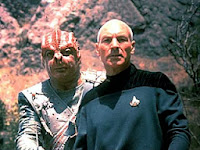 |
| Actor Paul Winfield as Captain Dathon on TNG |
The U.S.S. Enterprise receives a signal from "The Children of Tama," an alien race that has no history of violence, but whose language has been deemed "incomprehensible" to humans. Hovering above an uninhabited planet, Picard and the crew hope to establish relations with the Tamarians. But while he and Dathon, the Tamarian captain, make several attempts to communicate over their viewscreens, neither can understand the other. Suddenly Dathon turns to him, armed with two daggers, and both captains dematerialize and are transported to the surface of the planet below.
Pursued by a large, shimmering beast, Dathon again offers Picard his dagger and this time Picard accepts. As the two captains struggle to communicate in order to fight effectively, Picard hypothesizes that the Tamarians communicate by example, and the proper names and places they cite are references to situations in their history. Picard is then able to begin to communicate with Dathon, and the alien responds enthusiastically to his efforts.
Noted African-American actor Paul Winfield portrayed two powerful roles in his oportunities in the Star Trek universe: as the tragic Captain Clark Terrell in the bigscreen Star Trek II: The Wrath of Khan, and then on TNG in the role of metaphor-talking Tamarian captain Dathon in the classic "Darmok" episode.
 |
| Actor Avery Brooks as Benjamin Lafayette Sisko, Deep Space Nine |
Brooks is best known in popular culture for his role as Commander—and later Captain—Benjamin Sisko on the science fiction television series Star Trek: Deep Space Nine, which ran for seven seasons from 1993 to 1999.
Brooks won the role of Commander Benjamin Sisko by beating 100 other actors from all racial backgrounds to become the first African-American captain to lead a Star Trek series. What appealed to Brooks about the role was the opportunity to give hope to young people. "Today, many of our children, especially black males, do not project that they will live past the age of 19 or 20," he told Michael Logan of TV Guide. "Star Trek allows our children the chance to see something they might never otherwise imagine."
He directed nine episodes of the series, including "Far Beyond the Stars", an episode focusing on racial injustice.
Series producer Ronald D. Moore said of Brooks: "Avery, like his character (Sisko), is a very complex man. He is not a demanding or ego-driven actor, rather he is a thoughtful and intelligent man who sometimes has insights into the character that no one else has thought about. He has also been unfailingly polite and a classy guy in all my dealings with him." Wikipedia
| Actress Felicia M. Bell as Jennifer Sisko |
Felecia M. Bell played Jennifer Sisko and her mirror universe counterpart in Star Trek: Deep Space Nine. She is perhaps best known for her recurring roles in Days of Our Lives from 1990-92 and General Hospital from 1993-97. Bell has also guest starred in Hunter (with Barry Jenner), Night Man, ER, JAG (with J. Patrick McCormack and Eric Pierpoint), Smallville (with John Glover, Robert Picardo and Phil Morris), Law & Order and Law & Order: Special Victims Unit. Memory Alpha
 |
| Actress Penny Johnson as Kassidy Yates-Sisko |
Penny Johnson Jerald is an actress known to Star Trek fans for her role as Kassidy Yates in Star Trek: Deep Space Nine. She had previously played Dobara in the Star Trek: The Next Generation seventh season episode "Homeward" in 1993. Her costume from "Homeward" was later sold off on the It's A Wrap! sale and auction on eBay.
One of Johnson Jerald's early television guest appearances was in an episode of T.J. Hooker, starring William Shatner and her DS9 co-star James Darren. She was a regular cast member on The Larry Sanders Show with Scott Thompson and Wallace Langham as well as during the first three seasons of the popular FOX television series 24 where she played Sherry Palmer, the duplicitous ex-wife to the president of the United States. Memory Alpha
It's not quite Star Trek communications—yet. But long-distance communications in space may be easier now that researchers at the National Institute of Standards and Technology (NIST) and Jet Propulsion Laboratory (JPL) have designed a clever detector array that can extract more information than usual from single particles of light.
Described in a new paper,* the NIST/JPL array-on-a-chip easily identifies the position of the exact detector in a multi-detector system that absorbs an incoming infrared light particle, or photon. That's the norm for digital photography cameras, of course, but a significant improvement in these astonishingly sensitive detectors that can register a single photon. The new device also records the signal timing, as these particular single-photon detectors have always done.
The technology could be useful in optical communications in space. Lasers can transmit only very low light levels across vast distances, so signals need to contain as much information as possible.
One solution is "pulse position modulation" in which a photon is transmitted at different times and positions to encode more than the usual one bit of information. If a light source transmitted photons slightly to the left/right and up/down, for instance, then the new NIST/JPL detector array circuit could decipher the two bits of information encoded in the spatial position of the photon. Additional bits of information could be encoded by using the arrival time of the photon.
NIST:
Clever NIST/JPL Technology Decodes More Information from Single Photons, Laura Ost
WINSTON E. SCOTT (CAPTAIN, USN, RET.)
NASA ASTRONAUT (FORMER)
PERSONAL: Born August 6, 1950, in Miami, Florida. Married to the former Marilyn K. Robinson. They have two children. He enjoys martial arts and holds a 2nd degree black belt in Shotokan karate. He also enjoys music, and plays trumpet with various bands along the Cape Canaveral Space Coast. In addition he remains an active pilot flying various aircraft. Winston's father, Alston Scott, resides in Miami, Florida. His mother, Rubye Scott, is deceased.
EDUCATION: Graduated from Coral Gables High School, Coral Gables, Florida, in 1968; received a bachelor of arts degree in music from Florida State University in 1972; a master of science degree in aeronautical engineering from the U.S. Naval Postgraduate School in 1980. Awarded honorary doctorates from Florida Atlantic University in 1996, and Michingan State University in 2007.
ORGANIZATIONS: American Institute of Aeronautics & Astronautics; Aircraft Owners and Pilots Association; Experimental Aircraft Association; Skotokan Karate Association; Association of International Tohgi Karate-Do; Bronze Eagles Association of Texas.
EXPERIENCE: Scott entered Naval Aviation Officer Candidate School after graduation from Florida State University in December 1972. He completed flight training in fixed-wing and rotary-wing aircraft and was designated a Naval Aviator in August 1974. He then served a 4-year tour of duty with Helicopter Anti-Submarine Squadron Light Thirty Three (HSL-33) at the Naval Air Station (NAS) North Island, California, flying the SH-2F Light Airborne Multi-Purpose System (LAMPS) helicopter. In 1978 Scott was selected to attend the Naval Postgraduate School at Monterey, California, where he earned his Master of Science degree in aeronautical engineering with avionics. After completing jet training in the TA-4J Skyhawk, Scott served a tour of duty with Fighter Squadron Eighty Four (VF-84) at NAS Oceana, Virginia, flying the F-14 Tomcat. In June 1986 Scott was designated an Aerospace Engineering Duty Officer. He served as a production test pilot at the Naval Aviation Depot, NAS Jacksonville, Florida, flying the F/A-18 Hornet and the A-7 Corsair aircraft. He was also assigned as Director of the Product Support (engineering) Department. He was next assigned as the Deputy Director of the Tactical Aircraft Systems Department at the Naval Air Development Center at Warminster, Pennsylvania. As a research and development project pilot, he flew the F-14, F/A-18 and A-7 aircraft. Scott has accumulated more than 5,000 hours of flight time in 20 different military and civilian aircraft, and more than 200 shipboard landings. Additionally, Scott was an associate instructor of electrical engineering at Florida A&M University and Florida Community College at Jacksonville, Florida.
NASA SPACE FLIGHT EXPERIENCE: Scott was selected by NASA in March 1992, and reported to the Johnson Space Center in August 1992. He served as a mission specialist on STS-72 in 1996 and STS-87 in 1997, and has logged a total of 24 days, 14 hours and 34 minutes in space, including 3 spacewalks totaling 19 hours and 26 minutes.
NASA: Winston E. Scott, Captain, US Navy, (RET)
2004 Astronaut Candidate
There's some scientist in me. There's some explorer in me," says Dr. Bobby Satcher. "There's a humanitarian in me also. Space is the one venue that has the highest potential for benefiting people if we continue to be serious about exploring it."
Satcher, 38, a medical doctor who also holds a doctorate in chemical engineering, is one of 11 Americans selected to begin astronaut training this summer at NASA's Johnson Space Center in Houston. "I have always had an interest in service and an interest in science," says the future mission specialist. "I am interested in exploration, too. Becoming an astronaut lets me do all three."
Dr. Satcher comes to NASA from a research post at Northwestern University in Illinois. He's an orthopedic surgeon at Northwestern Memorial Hospital in Chicago.
"The focus of my research has been studying how bone cells respond to stresses," he says.
He brings his experience to NASA at a key time, when it's working to fulfill the new Vision for Space Exploration. The vision calls for NASA to focus its research efforts on studying the effects of long-duration space flight. "One problem when it comes to living and working in space is bone loss. I'm interested in looking at ways of preventing that," he says.
In his medical practice, Dr. Satcher treats patients who suffer from cancer in their arms and legs. He teaches doctors-in-training and graduate students as well. "The questions we're interested in are how the skeleton responds to external forces and how cancer spreads to the skeleton.
NASA: Bobby Satcher, M.D.
 |
| Comparing the value of mass in the universe derived using the CMB as compared with counts of galaxy clusters and gravitational lensing. (Courtesy: Adam Moss, Planck Collaboration) |
Scientists know that when they measure the total amount of matter in the universe using two competing methods, one will give a higher value for the total density of matter than the other. To resolve this measurement discrepancy, two separate research groups have now proposed that the missing mass might be in the form of neutrinos. Accurately measuring the total amount of matter in the universe is a crucial cosmological parameter for interpreting a vast number of astrophysical phenomena.
Neutrinos are difficult to study because they interact only by the weak nuclear force, which acts only over very short distances, and by gravity, which is extremely weak. In the Standard Model of particle physics, neutrinos come in three flavours – electron, muon and tau. They were once thought to be massless, but the discovery of neutrino oscillations – whereby neutrinos change flavour, requiring that their masses be different – implies at least two of them have mass, with the rate of oscillation depending on the mass difference of each flavour. The rate has been measured in particle-physics experiments such as Super-Kamiokande in Japan, which has allowed particle physicists to place a lower bound on the sum of the neutrino masses of 0.06 eV, but the absolute values remain unknown.
Physics World: Could sterile neutrinos solve the cosmological mass conundrum?
LELAND D. MELVIN (MR.)
ASSOCIATE ADMINISTRATOR FOR EDUCATION
NASA HEADQUARTERS
PERSONAL DATA: Born February 15, 1964 in Lynchburg, Virginia. Unmarried. Recreational interests include photography, piano, reading, music, cycling, tennis, and snowboarding. Loves walking his dogs, Jake and Scout. Chosen by the Detroit Lions in the 11th round of the 1986 NFL college draft. Also participated in the Toronto Argonauts and Dallas Cowboys football training camps. His parents Deems and Grace Melvin, reside in Lynchburg, Virginia.
EDUCATION: Graduated from Heritage High School, Lynchburg, Virginia, in 1982; received a bachelor of science degree in chemistry from the University of Richmond, Richmond, Virginia in 1986; and a master of science degree in materials science engineering from the University of Virginia in 1991.
ORGANIZATIONS: National Technical Association (Hampton Roads Chapter Secretary 1993), American Chemical Society, The Society for Experimental Mechanics.
SPECIAL HONORS/AWARDS: Invention Disclosure Award for Lead Insensitive Fiber Optic Phase Locked Loop Sensor, NASA Outstanding Performance Awards (8), NASA Superior Accomplishment Award (2), Key to the City of Lynchburg, Virginia, NCAA Division I Academic All American, University of Richmond Athletic Hall of Fame Inductee.
EXPERIENCE: Mr. Melvin began working in the Fiber Optic Sensors group of the Nondestructive Evaluation Sciences Branch at NASA Langley Research Center in 1989 where he conducted research in the area of physical measurements for the development of advanced instrumentation for Nondestructive Evaluation (NDE). His responsibilities included using optical fiber sensors to measure strain, temperature, and chemical damage in both composite and metallic structures. Additional projects included developing optical interferometric techniques for quantitative determination of damage in aerospace structures and materials. In 1994, Mr. Melvin was selected to lead the Vehicle Health Monitoring (VHM) team for the cooperative Lockheed/NASA X-33 Reuseable Launch Vehicle (RLV) program. The team developed distributed fiber optic strain, temperature and hydrogen sensors for the reduction of vehicle operational costs and to monitor composite liquid oxygen tank and cryogenic insulation performance. In 1996, Mr. Melvin codesigned and monitored construction of an optical NDE facility capable of producing in-line fiber optic Bragg grating strain sensors at rates in excess of 1000 per hour. This facility will provide a means for performing advanced sensor and laser research for development of aerospace and civil health monitoring systems.
NASA EXPERIENCE: Selected by NASA JSC in June 1998, Mr. Melvin reported for training in August 1998. Astronaut Candidate Training included orientation briefings and tours, numerous scientific and technical briefings, intensive instruction in Shuttle and International Space Station systems, physiological training and ground school to prepare for T-38 flight training, as well as learning water and wilderness survival techniques. Mr. Melvin has served the Astronaut Office Space Station Operations Branch, the Education Department at NASA Headquarters, Washington, D.C, and the Robotics Branch of the Astronaut Office. As co-manager of NASA's Educator Astronaut Program, Leland Melvin traveled across the country, engaging thousands of students and teachers in the excitement of space exploration, and inspiring them to pursue careers in science, technology, engineering and mathematics. A veteran of two space flights, STS-122 in 2008, and STS-129 in 2009, Leland Melvin has logged over 565 hours in space.
NASA: Leland D. Melvin (Mr.)
This focus on looks at the physics PhD production in the U.S. It presents trend data on the number of physics PhD awarded in the U.S. including data on citizenship, women, and minorities. It also includes data on time to degree, subfield of dissertation, and general satisfaction with degree. This report presents findings from the AIP annual survey of Enrollments and Degrees and the Degree Recipient Follow-up Survey.
The number of physics PhDs awarded in the U.S. continued to climb with the class of 2012 reaching a new high. The 1,762 physics PhDs awarded in the class of 2012 represented a 4% increase over the previous year and a 62% increase from a recent low 8 years earlier.
The representation of women at the PhD level has reached an all-time high in the class of 2012. In the class of 2012, 20% of the physics PhDs were earned by women, this is up from 13% 11 years earlier. This increase along with a growth in the overall number of physics PhDs awarded has resulted in a sharp increase in the number of women receiving degrees. Women earned 354 of the physics PhDs in the class of 2012, up from only 153 in 2001 (a 131% increase).
The proportion of non-U.S. citizens earning physics PhDs who are women is higher than for U.S. citizens. Women comprised 23% of the non-U.S. citizens in the class of 2012 and 17% of the U.S. citizens.
Hispanic Americans and African Americans continue to be under represented among physics PhD recipients when compared to 26 - 35 year olds in the U.S. population. The number of Hispanic Americans and African Americans earning physics PhDs averaged 28 and 17 degrees respectively for the classes of 2010 through 2012. Of the 195 departments that offered a physics PhD in 2012, 4 were located at an Historically Black College and University (HBCU). These 4 departments were responsible for one-third of the PhDs earned by African Americans in the classes of 2010 through 2012.
American Institute of Physics: Trends in Physics PhDs,
Patrick J. Mulvey and Starr Nicholson
NAME: BERNARD A. HARRIS, JR., (M.D.)
NASA ASTRONAUT
PERSONAL DATA: Born June 26, 1956, in Temple, Texas. Married to the former Sandra Fay Lewis of Sunnyvale, California. They have one child. He enjoys flying, sailing, skiing, running, scuba diving, art and music. Bernard's mother, Mrs. Gussie H. Burgess, and his stepfather, Mr. Joe Roye Burgess, reside in San Antonio, Texas. His father, Mr. Bernard A. Harris, Sr., resides in Philadelphia, Pennsylvania. Sandra's parents, Mr. & Mrs. Joe Reed, reside in Sunnyvale.
EDUCATION: Graduated from Sam Houston High School, San Antonio, Texas, in 1974; received a bachelor of science degree in biology from University of Houston in 1978, a doctorate in medicine from Texas Tech University School of Medicine in 1982. Dr. Harris completed a residency in internal medicine at the Mayo Clinic in 1985. In addition, he completed a National Research Council Fellowship at NASA Ames Research Center in 1987, and trained as a flight surgeon at the Aerospace School of Medicine, Brooks Air Force Base, San Antonio, Texas, in 1988. Dr. Harris also received a master's degree in biomedical science from the University of Texas Medical Branch at Galveston in 1996.
ORGANIZATIONS: Member of the American College of Physicians, American Society for Bone and Mineral Research, Aerospace Medical Association, National Medical Association, American Medical Association, Minnesota Medical Association, Texas Medical Association, Harris County Medical Society, Phi Kappa Phi Honor Society, Kappa Alpha Psi Fraternity, Texas Tech University Alumni Association, and Mayo Clinic Alumni Association. Aircraft Owners and Pilot Association. Association of Space Explorers. American Astronautical Society. Member, Board of Directors, Boys and Girls Club of Houston. Committee Member, Greater Houston Area Council on Physical Fitness and Sports. Member, Board of Directors, Manned Space Flight Education Foundation Inc.
SPECIAL HONORS: 1996 Honorary Doctorate of Science, Morehouse School of Medicine. Medal of Excellence, Golden State Minority Foundation 1996. NASA Award of Merit 1996. NASA Equal Opportunity Medal 1996. NASA Outstanding Leadership Medal 1996. The Challenger Award, The Ronald E. McNair Foundation 1996. Award of Achievement, The Association of Black Cardiologists 1996. Space Act Tech Brief Award 1995. Alpha Omega Alpha Medical Honor Society, Zeta of Texas Chapter 1995. Election of Fellowship in the American College of Physicians 1994. Distinguished Alumnus, The University of Houston Alumni Organization 1994. Distinguished Scientist of the Year, ARCS Foundation, Inc., 1994. Life Membership, Kappa Alpha Psi Fraternity. NASA Space Flight Medals 1993, 1995. NASA Outstanding Performance Rating 1993. JSC Group Achievement Award 1993. Physician of the Year, National Technical Association, 1993. Achiever of the Year, National Technical Association, 1993. American Astronautical Society Melbourne W. Boynton Award for Outstanding Contribution to Space Medicine 1993. Achievement Award, Kappa Alpha Psi Fraternity 1993. Who's Who Among Rising Young Americans Citation 1992. Certificate of Merit, Governor of Texas 1990. City of San Antonio Citation for Achievement 1990. NASA Sustained Superior Performance Award 1989. NASA Outstanding Performance Rating 1988. NASA Sustained Superior Performance Award 1988, 1989. National Research Council Fellowship 1986, 1987. Phi Kappa Phi Honor Society 1985. Outstanding Young Men of America 1984. University of Houston Achievement Award 1978. Achievement Award 1978.
In this recent public lecture at the Library of Congress, Neil deGrasse Tyson discussed the importance of scientific education and how the basic human needs drive our technology forward.
Neil deGrasse Tyson is an American astrophysicist and a science communicator. He is currently the Frederick P. Rose Director of the Hayden Planetarium at the Rose Center for Earth and Space and a research associate in the department of astrophysics at the American Museum of Natural History. He has appeared on or hosted a number of television programs promoting science, education, critical thinking and space exploration. For more videos with Neil deGrasse Tyson use the search function. PhysicsDatabase.com
FREDERICK D. GREGORY (COLONEL, USAF, RET.)
NASA ASTRONAUT (FORMER)
PERSONAL DATA: Born January 7, 1941, in Washington, D.C. His wife, the former Barbara Archer of Washington, D.C., is deceased. They have two grown children. Frederick, D., Jr., is a Captain in the Air Force, and a graduate of Stanford University. Heather Lynn is a social worker and graduate of Sweet Briar College. Recreational interests include water skiing, fishing, hunting, specialty cars, and stereo equipment.
EDUCATION: Graduated from Anacostia High School, Washington, D.C., in 1958; received a bachelor of science degree from the United States Air Force Academy in 1964, and a master’s degree in information systems from George Washington University in 1977.
ORGANIZATIONS: Member, Society of Experimental Test Pilots, Order of Daedalians, American Helicopter Society, Air Force Academy Association of Graduates, the Air Force Association, Sigma Pi Phi Fraternity, the National Technical Association, and the Tuskegee Airmen. He is also on the Board of Directors for the Young Astronaut Council, the Challenger Center for Space Science Education, and the Virginia Air and Space Center-Hampton Roads History Center.
SPECIAL HONORS: Awarded the Defense Superior Service Medal, 2 Distinguished Flying Crosses, the Defense Meritorious Service Medal, the Meritorious Service Medal, 16 Air Medals, the Air Force Commendation Medal, and 3 NASA Space Flight Medals. Recipient of the NASA Outstanding Leadership Award; the National Society of Black Engineers Distinguished National Scientist Award (1979); an honorary doctor of science degree from the University of the District of Columbia (1986); and the George Washington University Distinguished Alumni Award. Designated an "Ira Eaker Fellow" by the Air Force Association. Recipient of numerous NASA group and individual achievement awards as well as civic and community awards.
On this week's podcast, our contributor, Elizabeth Case, reports from a conference for undergraduate women in physics from this past week.
Elizabeth also participated in the conference herself as an undergraduate physics student, granting her an inside perspective on how such conferences can inform, inspire, and retain women in physics. Have a listen! PhysicsCentral.com
